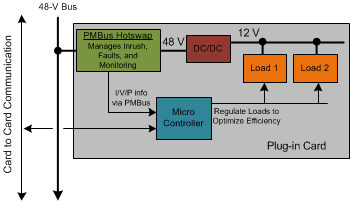SNVS655I June 2011 – January 2016 LM5066
PRODUCTION DATA.
- 1 Features
- 2 Applications
- 3 Description
- 4 Revision History
- 5 Device Comparison Table
- 6 Pin Configuration and Functions
- 7 Specifications
-
8 Detailed Description
- 8.1 Overview
- 8.2 Functional Block Diagram
- 8.3 Feature Description
- 8.4 Device Functional Modes
- 8.5
Programming
- 8.5.1 PMBus Command Support
- 8.5.2
Standard PMBus Commands
- 8.5.2.1 OPERATION (01h)
- 8.5.2.2 CLEAR_FAULTS (03h)
- 8.5.2.3 CAPABILITY (19h)
- 8.5.2.4 VOUT_UV_WARN_LIMIT (43h)
- 8.5.2.5 OT_FAULT_LIMIT (4Fh)
- 8.5.2.6 OT_WARN_LIMIT (51h)
- 8.5.2.7 VIN_OV_WARN_LIMIT (57h)
- 8.5.2.8 VIN_UV_WARN_LIMIT (58h)
- 8.5.2.9 STATUS_BYTE (78h)
- 8.5.2.10 STATUS_WORD (79h)
- 8.5.2.11 STATUS_VOUT (7Ah)
- 8.5.2.12 STATUS_INPUT (7Ch)
- 8.5.2.13 STATUS_TEMPERATURE (7dh)
- 8.5.2.14 STATUS_CML (7Eh)
- 8.5.2.15 STATUS_MFR_SPECIFIC (80h)
- 8.5.2.16 READ_VIN (88h)
- 8.5.2.17 READ_VOUT (8Bh)
- 8.5.2.18 READ_TEMPERATURE_1 (8Dh)
- 8.5.2.19 MFR_ID (99h)
- 8.5.2.20 MFR_MODEL (9Ah)
- 8.5.2.21 MFR_REVISION (9Bh)
- 8.5.3
Manufacturer Specific PMBus Commands
- 8.5.3.1 MFR_SPECIFIC_00: READ_VAUX (D0h)
- 8.5.3.2 MFR_SPECIFIC_01: MFR_READ_IIN (D1h)
- 8.5.3.3 MFR_SPECIFIC_02: MFR_READ_PIN (D2h)
- 8.5.3.4 MFR_SPECIFIC_03: MFR_IN_OC_WARN_LIMIT (D3h)
- 8.5.3.5 MFR_SPECIFIC_04: MFR_PIN_OP_WARN_LIMIT (D4h)
- 8.5.3.6 MFR_SPECIFIC_05: READ_PIN_PEAK (D5h)
- 8.5.3.7 MFR_SPECIFIC_06: CLEAR_PIN_PEAK (D6h)
- 8.5.3.8 MFR_SPECIFIC_07: GATE_MASK (D7h)
- 8.5.3.9 MFR_SPECIFIC_08: ALERT_MASK (D8h)
- 8.5.3.10 MFR_SPECIFIC_09: DEVICE_SETUP (D9h)
- 8.5.3.11 MFR_SPECIFIC_10: BLOCK_READ (DAh)
- 8.5.3.12 MFR_SPECIFIC_11: SAMPLES_FOR_AVG (DBh)
- 8.5.3.13 MFR_SPECIFIC_12: READ_AVG_VIN (DCh)
- 8.5.3.14 MFR_SPECIFIC_13: READ_AVG_VOUT (DDh)
- 8.5.3.15 MFR_SPECIFIC_14: READ_AVG_IIN (DEh)
- 8.5.3.16 MFR_SPECIFIC_15: READ_AVG_PIN
- 8.5.3.17 MFR_SPECIFIC_16: BLACK_BOX_READ (E0h)
- 8.5.3.18 MFR_SPECIFIC_17: READ_DIAGNOSTIC_WORD (E1h)
- 8.5.3.19 MFR_SPECIFIC_18: AVG_BLOCK_READ (E2h)
- 8.5.4 Reading and Writing Telemetry Data and Warning Thresholds
- 8.5.5 Determining Telemetry Coefficients Empirically With Linear Fit
- 8.5.6 Writing Telemetry Data
- 8.5.7 PMBus Address Lines (ADR0, ADR1, ADR2)
- 8.5.8 SMBA Response
-
9 Application and Implementation
- 9.1 Application Information
- 9.2
Typical Application
- 9.2.1
48-V, 10-A PMBus Hotswap Design
- 9.2.1.1 Design Requirements
- 9.2.1.2
Detailed Design-In Procedure
- 9.2.1.2.1 Select RSNS and CL Setting
- 9.2.1.2.2 Selecting the Hotswap FETs
- 9.2.1.2.3 Select Power Limit
- 9.2.1.2.4 Set Fault Timer
- 9.2.1.2.5 Check MOSFET SOA
- 9.2.1.2.6 Set UVLO and OVLO Thresholds
- 9.2.1.2.7 Power Good Pin
- 9.2.1.2.8 Input and Output Protection
- 9.2.1.2.9 Final Schematic and Component Values
- 9.2.1.3 Application Curves
- 9.2.1
48-V, 10-A PMBus Hotswap Design
- 10Power Supply Recommendations
- 11Layout
- 12Device and Documentation Support
- 13Mechanical, Packaging, and Orderable Information
パッケージ・オプション
メカニカル・データ(パッケージ|ピン)
- PWP|28
サーマルパッド・メカニカル・データ
- PWP|28
発注情報
1 Features
- 10- to 80-V Operation
- 100-V Continuous Absolute Max
- 26 mV (±12%) or 50 mV (±6%) ILIM Threshold
- Programmable FET SOA Protection
- Programable UV, OV, tFAULT Thresholds
- External FET Temperature Sensing
- Failed FET Detection
- I2C / SMBus Interface
- PMBus™ Compliant Command Structure
- Precision V IN, VOUT, IIN, PIN, VAUX Monitoring
- V (±2.7%); I (±3%); P (±4.5%)
- Programable I/V/P Averaging Interval
- 12-bit ADC with 1-kHz Sampling Rate
- –40°C < TJ < 125°C Operation
- Pin-to-Pin Compatible with LM5066I
2 Applications
- 48-V Servers
- Base Station Power Distribution
- Networking Routers and Switchers
- PLC Power Management
- 24- to 28-V Industrial Systems
3 Description
LM5066 provides robust protection and precision monitoring for 10- to 80-V systems. Programmable UV, OV, ILIMIT, and fast-short circuit protection allow for customized protection for any application. Programmable FET SOA protection sets the maximum power the FET is allowed to dissipate under any condition. The programmable fault timer (tFAULT) is set to avoid nuisance trips, ensure start-up, and limit the duration of over load events.
In addition to circuit protection, the LM5066 supplies real-time power, voltage, current, temperature, and fault data to the system management host through the I2C / SMBus interface. PMBus compliant command structure makes it easy to program the device. Precision telemetry enables intelligent power management functions such as efficiency optimization and early fault detection. LM5066 also supports advanced features such as I/V/P averaging and peak power measurment to improve system diagnostics.
LM5066I is pin-to-pin compatible with the LM5066 and offers improved telemetry accuracy and supports the Read_Ein command to monitor energy. See Table 1 for a detailed comparison.
Device Information(1)
| PART NUMBER | PACKAGE | BODY SIZE (NOM) |
|---|---|---|
| LM5066 | PWP (28) | 9.70 × 4.40 mm2 |
SPACE
Simplified Schematic

LM5066 in a Plug-in Card
